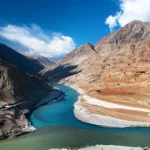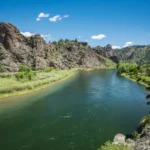
Jeju Island is a volcanic island in South Korea’s Korea Strait. It is located southwest of South Jeolla Province, 53 miles from the Korean peninsula’s tip. It was a part of South Jeolla Province until 1946, when it became a separate province. The island was originally known as ‘Cheju.’ Jeju City is the capital of Jeju Island, just as New York City is the capital of New York State. Jeju Island was formed by lava from Halla Mountain approximately 2 million years ago.
Interesting facts about Jeju Island:
Hallasan (Halla Mountain), South Korea’s highest peak, is located on Jeju Island. The mountain’s peak resembles a massive crater.
It’s a popular honeymoon destination for newlywed Koreans. It has stunning beaches and waterfalls that will take your breath away. It’s a tropical haven.
Jeju Island is one of nine provinces in South Korea.
The island has a temperate climate. Even in the winter, temperatures rarely drop below freezing.
When the lava erupting from the volcano cooled, it formed lava tubes, which formed a lava cave system. This cave system, along with Halla Mountain and Seongsan Sunrise Peak, contributed to the island’s designation as a UNESCO World Heritage Site in 2007. It is known as Jeju Volcanic Island and Lava Tubes.
Hallasan Mountain on Jeju Island is a dormant volcano. It is located at an elevation of 1,950 meters above sea level. The volcano last erupted approximately 800 years ago. It is thought to have formed around 25,000 years ago.
A lake exists within the crater of Hallasan Mountain. Baengnokdam is the name of the crater.
Jeju Island is also known as the “Hawaii of Korea.” It is also known as Samdado, which translates as “three abundances island.” This refers to three abundances: wind, rocks, and women. The women are said to be very attractive.
There are stone statues called ‘dolharubang,’ which translates to’stone grandfather.’ In 1750, the first was carved from lava rock. These life-sized statues depict helmet-wearing men. There are 45 of these statues left today. In 1971, the Jeju-mok statue was designated as the island’s mascot.
Mongolians used it as a horse training ground in the 11th century. It was later used as a prison and a fort to protect against Japanese pirates.
During the Koran War, many refugees sought refuge on the island.
It wasn’t until the 1960s and 1970s that it became a popular tourist destination.
Jeju Island is Korea’s smallest province.
Jeju Island is Korea’s largest island. It covers a total area of 1,846 square kilometers.
More plants have been recorded growing at Mt. Hallasan National Park than on any other mountain. Only 33 of these plants can be found on this mountain.
There are 947 insect species on Jeju Island. It also has 8 different reptiles, 8 different amphibians, 198 different bird species, and over 17 mammals.
Jeju Island is one of the New Seven Natural Wonders of the World. This list was compiled using data from a global pole taken between 2007 and 2011.










I really appreciate the depth of research and analysis you put into this post. It’s clear that you’ve done your homework and have a deep understanding of the topic. I learned so much from reading this and I’m looking forward to checking out your other content as well